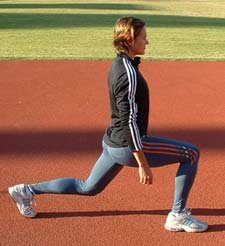It is a well known fact that huge amounts of forces are placed on the joints, muscles and bone structure with plyometrics and even more so with HIP.
HIP exercises are plyometric exercise that I have developed over the years of coaching sprinters, hurdles and jumpers.

What Muscles Are Worked

Major Muscles Worked When Performing These Exercises Are:
- Gluteus Maximus - Learn More
- Quadriceps - Learn More
- Tensor Facia Latae - Learn More
- Gastrocnemius - Learn More
- Soleus - Learn More

Warm-Up

Warm Up For These Jumps Over A Distance Of 15- 20m:
- Marching - Focus on proper biomechanics of the arms, legs and feet.
- Jogging - High knees, butt kicks, toe jogging, ext.
- Skipping - Mimics the quick take-off and landing. From the small
movements to the more vigorous. - Lunges - Part of the warm up.
- Ankle Hops & Small Jumps.

The Exercises

All these jumps start off in the lunge position.
Make sure your upper body stays in the upright position, and ensure you have good core stability before attempting these jumps.
As a precaution I recommend that the front knee does not move forward beyond the toes as this places extreme force on the knee joints and ligaments.
- Lunge Jump With A Twist:
Start off in a normal lunge but move the arms (Elbow extended) and hands to a position in front of the body and then to the side of the leading leg. Upon jumping up change leading legs and the arms accordingly. As mentioned before, a good exercise to help develop not only explosiveness but also your core stabilization muscles.
- Lunge Jump With Enhanced Hip Flexion & Extension:
Start off in the lunge position. Jump up and once in the air, bring the front knee farther up and extend the back leg even more. Before landing bring the legs back into the starting lunge position. Do 2 - 5 sets of 4 - 6 reps on a leg and change front legs.
- Lunge Jump Landing With Alternating Legs In Front:
Start off as mentioned in the lunge jump position. Jump up as high as possible, but once in the air alternate the legs so the back leg becomes the front landing leg. Do 4 - 6 reps per leg as a set.
- Lunge Cycle Jump:
Start the same as above mentioned. Once in the air, do a hip flexion with the back leg (So it becomes the front leg) and knee flexion with the now back leg. But before landing return the legs to the starting position.
- Highland Swing:
This jump starts off by standing with your feet next to one another. Bend your knees and jump up as high as you can and perform a hip flexion with one leg and bending the back leg knee. Before landing bring the feet next to one another. With the next jump up, alternate the legs. Do 2 -4 sets of 5 reps per leg.


























